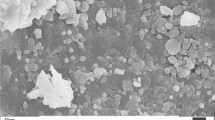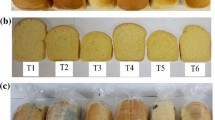Abstract
Germination can be used to improve the sensory and nutritional properties of cereal and pseudocereal grains. Oat and quinoa are rich in minerals, vitamins and fibre while quinoa also contains high amounts of protein of a high nutritional value. In this study, oat and quinoa malts were produced and incorporated in a rice and potato based gluten free formulation. Germination of oat led to a drastic increase of α-amylase activity from 0.3 to 48 U/g, and minor increases in proteolytic and lipolytic activities. Little change was observed in quinoa except a decrease in proteolytic activity from 9.6 to 6.9 U/g. Oat malt addition decreased batter viscosities at both proofing temperature and during heating. These changes led to a decrease in bread density from 0.59 to 0.5 g/ml and the formation of a more open crumb, but overdosing of oat malt deteriorated the product as a result of excessive amylolysis during baking. Quinoa malt had no significant effect on the baking properties due to low α-amylase activity. Despite showing a very different impact on the bread quality, both malts influenced the electrophoretic patterns of rice flour protein similarly. This suggests that malt induced proteolysis does not influence the technological properties of a complex gluten free formulation.


Similar content being viewed by others
Abbreviations
- CD:
-
Celiac disease
- CLSM:
-
Confocal laser scanning microscopy
- EFSA:
-
European Food Safety Authority
- FDA:
-
US Food and Drug Administration
- FITC:
-
Fluorescein isothiocyanate
- HPMC:
-
Hydroxypropylmethylcellulose
- RVA:
-
Rapid visco analyzer
- SEM:
-
Scanning electron microscopy
- WPI:
-
Whey protein isolate
- λex :
-
Excitation wavelength
References
Catassi C, Fasano A (2008) Celiac disease. Curr Opin Gastroenterol 24:687
Butzner JD (2011) Pure oats and the gluten-free diet. JPEN 35:447
Kemppainen T, Janatuinen E, Holm K, Kosma VM, Heikkinen M, Mäki M, Laurila K, Uusitupa M, Julkunen R (2007) No observed local immunological response at cell level after five years of oats in adult coeliac disease. Scand J Gastroenterol 42:54–59
Bergamo P, Maurano F, Mazzarella G, Iaquinto G, Vocca I, Rivelli AR, De Falco E, Gianfrani C, Rossi M (2011) Immunological evaluation of the alcohol–soluble protein fraction from gluten–free grains in relation to celiac disease. Mol Nutr Food Res 55:1266–1270
Hager AS, Axel C, Arendt E (2011) Status of carbohydrates and dietary fiber in gluten-free diets. Cereal Foods World 56:109–114. doi:10.1094/CFW-56-3-0109
Lee A, Ng D, Dave E, Ciaccio E, Green P (2009) The effect of substituting alternative grains in the diet on the nutritional profile of the gluten–free diet. J Hum Nutr Diet 22:359–363
Lásztity R (1998) Oat grain - A wonderful reservoir of natural nutrients and biologically active substances. Food Rev Int 14:99–119
Wood PJ (2010) Review: Oat and rye β-glucan: properties and function. Cereal Chem 87:315–330
Repo-Carrasco R, Espinoza C, Jacobsen SE (2003) Nutritional value and use of the Andean crops quinoa (Chenopodium quinoa) and kañiwa (Chenopodium pallidicaule). Food Rev Int 19:179–189
Ruales J, Nair BM (1992) Nutritional quality of the protein in quinoa (Chenopodium quinoa, Willd) seeds. Plant Foods Hum Nutr 42:1–11
Jacobsen S, Mujica A, Ortiz R (2003) The global potential for quinoa and other Andean crops. Food Rev Int 19:139–148
FAO (2011) Quinoa: An ancient crop to contribute to world food security. Vitacura, Santiago de Chile
Kaukovirta-Norja A, Wilhelmson A, Poutanen K (2004) Germination: A means to improve the functionality of oat. Agric Food Sci 13:1–2
Valencia US, Sandberg ΑS, Ruales J (1999) Processing of quinoa (Chenopodium quinoa, Willd): Effects on in vitro iron availability and phytate hydrolysis. Int J Food Sci Nutr 50:203–211
Kim D-W, Jeong SC, Gorinstein S, Chon S-U (2012) Total polyphenols, antioxidant and antiproliferative activities of different extracts in mungbean seeds and sprouts. Plant Foods Hum Nutr 67:71–75
Hugo L, Rooney L, Taylor J (2000) Malted sorghum as a functional ingredient in composite bread. Cereal Chem 77:428–432
Mäkinen OE, Arendt EK (2012) Oat malt as a baking ingredient - A comparative study of the impact of oat, barley and wheat malts on bread and dough properties. J Cereal Sci 56:747–753. doi:10.1016/j.jcs.2012.08.009
Park S, Morita N (2005) Dough and breadmaking properties of wheat flour substituted by 10 % with germinated quinoa flour. Food Sci Technol Int 11:471–476
Watanabe M, Maeda T, Tsukahara K, Kayahara H, Morita N (2004) Application of pregerminated brown rice for breadmaking. Cereal Chem 81:450–455
Matlashewski G, Urquhart A, Sahasrabudhe M, Altosaar I (1982) Lipase activity in oat flour suspensions and soluble extracts. Cereal Chem 59:418–422, AGR:IND82116980
Kwon DY, Rhee JS (1986) A simple and rapid colorimetric method for determination of free fatty acids for lipase assay. J Am Oil Chem Soc 63:89–92
Moroni A, Iametti S, Bonomi F, Arendt E, Dal Bello F (2010) Solubility of proteins from non-gluten cereals: A comparative study on combinations of solubilising agents. Food Chem 121:1225–1230
Gabriele D, de Cindio B, D’Antona P (2001) A weak gel model for foods. Rheol Acta 40:120–127
Nunes MHB, Moore MM, Ryan LAM, Arendt EK (2009) Impact of emulsifiers on the quality and rheological properties of gluten-free breads and batters. Eur Food Res Technol 228:633–642
Atwell W, Hyldon R, Godfrey P, Galle E, Sperber W, Pedersen D, Evans W, Rabe G (1988) Germinated quinoa flour to reduce the viscosity of starchy foods. Cereal Chem 65:508–509
Lásztity R (1996) Rice proteins. In: Lásztity R (ed), The Chemistry of Cereal Proteins, 2nd edn. CRC, Boca Raton, pp 249–273
Moroni AV, Bello FD, Zannini E, Arendt EK (2011) Impact of sourdough on buckwheat flour, batter and bread: Biochemical, rheological and textural insights. J Cereal Sci 54:195–202
Renzetti S, Arendt EK (2009) Effect of protease treatment on the baking quality of brown rice bread: From textural and rheological properties to biochemistry and microstructure. J Cereal Sci 50:22–28
Renzetti S, Arendt EK (2009) Effects of oxidase and protease treatments on the breadmaking functionality of a range of gluten-free flours. Eur Food Res Technol 229:307–317
Gujral HS, Haros M, Rosell CM (2003) Starch hydrolyzing enzymes for retarding the staling of rice bread. Cereal Chem 80:750–754
Primo-Martín C, Hamer RJ, de Jongh HHJ (2006) Surface layer properties of dough liquor components: Are they key parameters in gas retention in bread dough? Food Biophys 1:83–93
Acknowledgments
The authors wish to thank Eva Bernardis for technical assistance. This study was funded by the Food Institutional Research Measure (FIRM) administered by the Department of Agriculture, Fisheries and Food (Ireland).
Author information
Authors and Affiliations
Corresponding author
Rights and permissions
About this article
Cite this article
Mäkinen, O.E., Zannini, E. & Arendt, E.K. Germination of Oat and Quinoa and Evaluation of the Malts as Gluten Free Baking Ingredients. Plant Foods Hum Nutr 68, 90–95 (2013). https://doi.org/10.1007/s11130-013-0335-3
Published:
Issue Date:
DOI: https://doi.org/10.1007/s11130-013-0335-3




